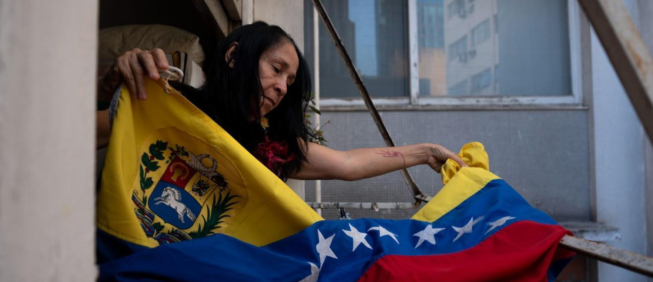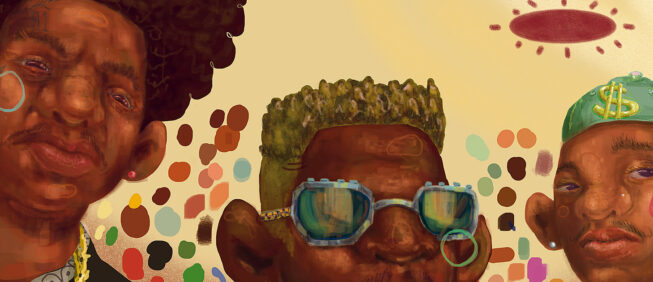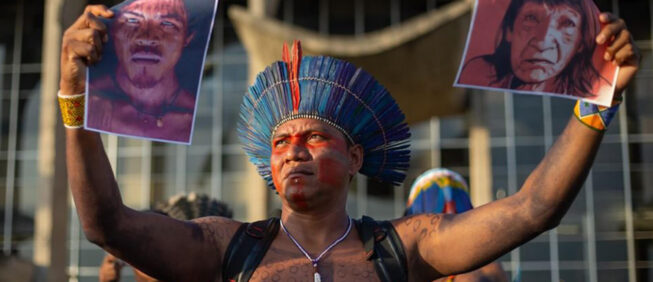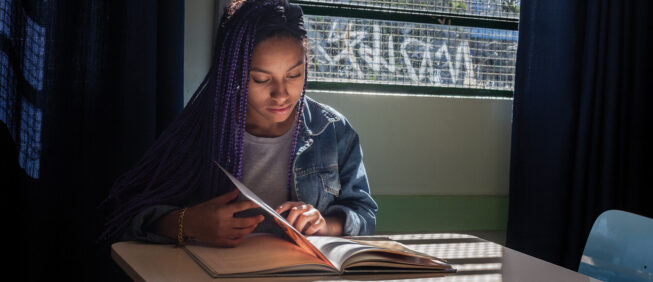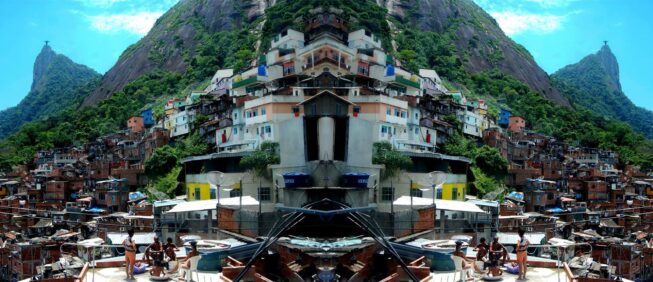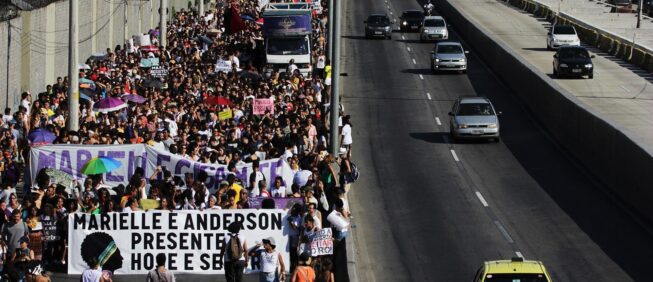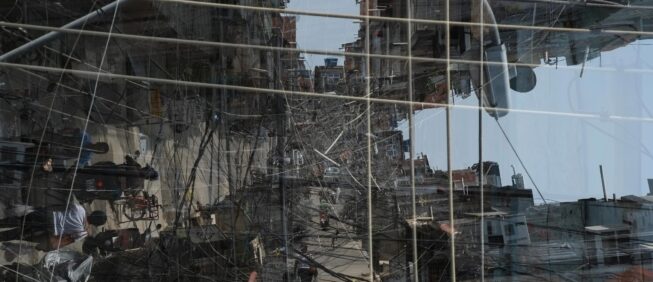Art in the Age of Mass Incarceration
Prison art produced by incarcerated people, and their market relations and imposed institutional control
Nicole Fleetwood
| USA |
August, 2022
Excerpted from MARKING TIME: ART IN THE AGE OF MASS INCARCERATION by Nicole R. Fleetwood, published by Harvard University Press
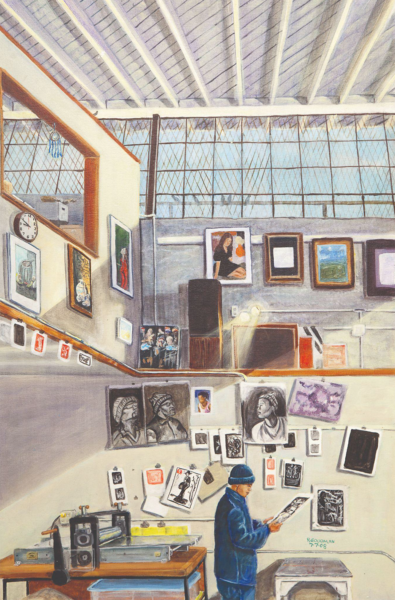
In Ronnie Goodman’s 2008 painting San Quentin Arts in Corrections Art Studio, the artist is alone at work in a studio. The self-portrait locates him inside a cavernous space of multistoried walls and beamed ceilings. We see him in profile, from the knees up, dressed all in blue and bent slightly forward, studying a print.
The painting’s elements —his solo presence, surrounded by stillness, and his relaxed stance, with angled head and paper in hand—suggest an immersive state of creativity and concentration. On the walls, dwarfing him and above his reach, are portraits, landscape paintings, and still life renditions. It is morning, gauging from the clock behind him and the light pouring in through the glass block windows that run the length of the wall. The details of the workspace — the light, the height, and the open floor plan — all suggest an idyllic scene for the creation of art.
Goodman’s painting, indeed, references a long tradition of documenting the artist at work in a studio, art class, museum, or other institutional setting, such as Samuel Morse’s Gallery of the Louvre (1831–1833) and Kerry James Marshall’s Untitled (Studio) (2014). It is an act of self-invention in which Goodman inserts himself into studio art traditions.
Goodman made the painting while he was incarcerated at San Quentin State Prison and a participant in the Arts in Corrections workshop run by the William James Association, a nonprofit organization that provides art classes in prisons throughout California. Though the workshop takes place in a prison, there are no figures of authority or evidence of punitive captivity immediately visible in the painting, except for Goodman’s uniform and the surveillance window in the upper left corner: a sign of penal supervision through which correction officers can monitor incarcerated people while remaining out of sight.
The prison studio, in Goodman’s painting, is a place of imaginative possibility as well as a place constrained by his incarceration and the layered history of the carceral state. He meditates on his status as prisoner and artist—portraying himself creating in this space while being marked by his prison blues and the invisible surveillance of the prison staff. His painting reflects on the conditions under which art is made within prisons while also reimagining the space by curating the wall display inside the painting. He is studying both a work in hand and the space around him.
Goodman brings some pieces closer to him, highlighting works that he favors. “I kind of rearranged it the way I wanted it on the wall. It wasn’t like that arbitrarily. I fixed certain things the way I wanted it done. I wanted to make sure I had a lot of my stuff. That was the piece I was looking at in my hand... I’m drawing my stuff, so you can see, and you can see other people’s work I liked that was there.”1Ronnie Goodman, interview with the author, 21 July 2017. He has altered and curated the penal space, positioning portraits of his friends nearby and asserting his vision while being held captive.
His representation of the workshop is an act of aesthetic discernment. It also represents a striking contrast to the tiny cells where Goodman and other imprisoned people spend the majority of their time. In those cells, incarcerated people dream, plan, collect material, and make art that often goes undetected by prison authorities and unlicensed by teachers and administrators.
Goodman’s self-portrait foregrounds how the work of art emerges in relation to institutions, be they entities commonly associated with art, like ateliers, conservatories, museums, and galleries, or other institutional sites, like primary schools, subway stations, public streets, and even prisons. The painting is an example of what I call “carceral aesthetics,” which refers to ways of envisioning and crafting art and culture that reflect the conditions of imprisonment.
Every year, incarcerated people create millions of paintings, drawings, sculptures, greeting cards, collages, and other visual materials that circulate inside prisons; between incarcerated people and their loved ones; in private collections of the imprisoned, prison staff, teachers, and others; and more recently in public domains and institutions like museums, libraries, hospitals, and universities. Prison art is produced in a number of ways and for different audiences: through programs run by prisons, through organizations that bring art instruction and services into prisons, through formal and informal networks of incarcerated people who share art and supplies, and through collaborations between incarcerated people and nonincarcerated artists, allies, relatives, and friends. The majority of art-making in prisons takes place in cells and prison hobby shops, where incarcerated people improvise and experiment with the numerous constraints under which they serve penal time.
Marking Time: Art in the Age of Mass Incarceration is about both the centrality of prisons to contemporary art and culture, and the robust world of art-making inside US prisons. It emphasizes the aesthetic engagement and knowledge worlds of people largely excluded from civic life, art establishments, and public culture— people warehoused in US prisons—through examining art by incarcerated people, both solo and in collaboration with nonincarcerated artists, activists, and teachers, practices that explore the expansive reach of the carceral state.
Prison art practices resist the isolation, exploitation, and dehumanization of carceral facilities. They reconstitute what productivity and labor mean in states of captivity, as many of these works entail laborious, time-consuming, and immersive practices and planning. Art-making in prison is also important to consider as part of the larger contemporary art world, although prison art rarely appears in public galleries or museums. But established art institutions do not reflect the vast amount of art practices in any given era. To consider art by incarcerated people as existing outside of art discourses or institutions rehearses the violent erasure of being imprisoned. Like art made in other arenas, prison art exists in relation to economies, power structures governing resources and access, and discourses that legitimate certain works as art and others as craft, material object, historical artifact, or trash.
Visual art is just one arena of a broader world of cultural production in prisons. Prison literature, music, and theater have received more attention by scholars, writers, and advocates. Writings from prison, like the works of Malcolm X, Angela Davis, Oscar Wilde, Etheridge Knight, Antonio Gramsci, Jimmy Santiago Baca, Jack Henry Abbott, and George Jackson, are taught regularly in university courses. Sharon Luk’s 2018 book, The Life of Paper: Letters and a Poetics of Living beyond Captivity, offers a stunning and rich analysis of the significance of letter correspondence between incarcerated people and their loved ones and communities over various historical moments; she emphasizes the poetics and materiality of letter writing.2Sharon Luk, The Life of Paper: Letters and a Poetics of Living beyond Captivity (Berkeley: University of California Press, 2018).
Collections of prison sound recordings have been produced for decades, and prison theater has been staged and anthologized. Less attention has been paid to the visual. A notable exception is Phyllis Kornfeld’s Cellblock Visions: Prison Art in America (1997), an informative dive into art-making in prisons based on Kornfeld’s years of teaching in various facilities and states. Kornfeld sets out to focus on art, and not the politics of prison, writing that she leaves that for experts of prison reform. 33. Phyllis Kornfeld, Cellblock Visions: Prison Art in America (Princeton, NJ: Princeton Uni-versity Press, 1997), xxv. I set out to engage the politics of art-making in prisons, and, more expansively, art as politics in an era of massive human caging and under other forms of carceral power. How has the colossal reach of the prison industrial complex shaped contemporary art institutions and art-making? And how does visual art help to reveal the depths and devastation of our nation’s punishment system?
Take, for example, the paintings I Am the Economy (2018) and How Big House Products Make Boxer Shorts (2018), by artist James “Yaya” Hough, made while imprisoned in Pennsylvania. In both works, the unclothed body of a black man appears to be fed into a machine operated by a white man in uniform. In I Am the Economy, the other end of the machine churns out dollar bills as the racialized prison population is “harshly and mechanically converted into cash by the prison industrial complex.” 44. James “Yaya” Hough, artist statement, Capitalizing on Justice exhibit, presented by Worth Rises, 2018, https://correctionsaccountability.org/capitalizingonjustice/ In How Big House Products Make Boxer Shorts, the captive body produces commodity goods, in this case underpants, that are sold back to incarcerated people.
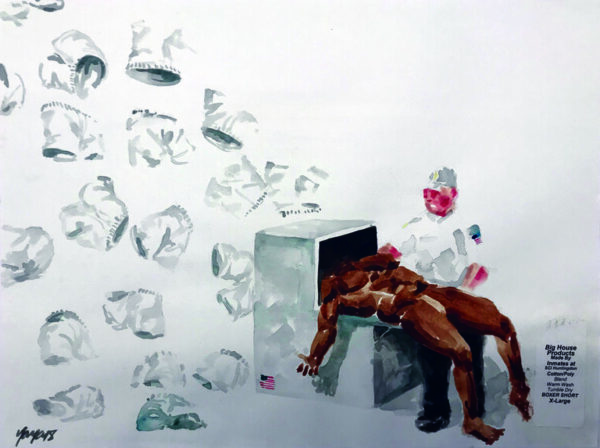
The bodies of imprisoned black men in Hough’s paintings fuel prisons by employing people like the uniformed white man operating the machine, the vendors who sell commodities, those who profit from the financialization of prisons and carceral facilities, and other networks and entities entangled in carceral governance. Hough’s work visualizes what esteemed scholar and prison abolition activist Ruth Wilson Gilmore describes as the extractive processes of the prison industrial complex: “Prisons enable money to move because of the enforced inactivity of people locked in them.
It means people extracted from communities, and people returned to communities but not entitled to be of them, enable the circulation of money on rapid cycles. What’s extracted from the extracted is the resource of life—time.”5Ruth Wilson Gilmore, “Abolition Geography and the Problem of Innocence,” Futures of Black Radicalism, ed. Gaye Theresa Johnson and Alex Lubin (Brooklyn, NY: Verso, 2017), 227. Hough’s art also echoes the concerns of nonincarcerated conceptual artist Cameron Rowland, whose works explore the extractive and exploitive processes of black subjugation and confinement under racial capitalism. One artist in a prison cell in Pennsylvania, the other in a studio in New York City, unaware of each other, make art that diagnoses the extractive practices of prisons as a continuance of the subjugation of black people.
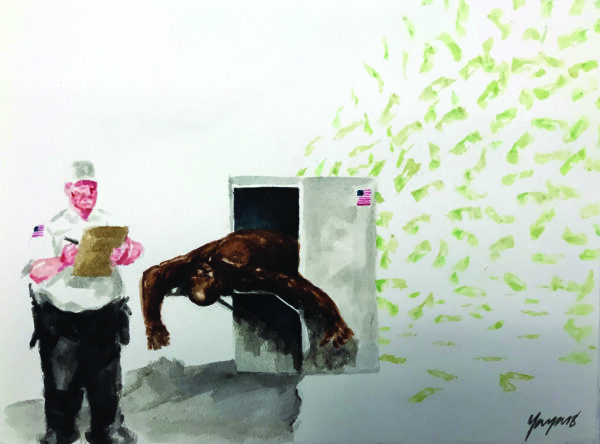
Both Hough’s and Rowland’s practices challenge the “inside” and “outside” logic of carcerality. Yet this idea of separation between the incarcerated and the nonincarcerated underpins the rationale of locking people up in cages and rendering them invisible as a measure of safety. Through artistic practices and creative communities inside prison, incarcerated artists fight the punitive isolation and severance of relationships that prisons impose. They work to undermine the carceral indexes, meaning the data and records—like mug shots —that mark people as criminal and incarcerated subjects, and the stigma of being a prisoner. Prison art is part of the long history of captive people envisioning freedom— creating art, imagining worlds, and finding ways to resist and survive.
Jared Owens, a formerly incarcerated artist, once described to me the risks involved in experimenting with art while in a federal prison. As an abstract painter, he wanted to make works larger than the canvases permitted. He saw a wood plank that would allow him to stretch a larger canvas. He decided to acquire the plank, which meant he would need to avoid detection by prison staff. Owens stated, “That was the longest three yards of my life.” I couldn’t shake his words and the significance of the risk-taking involved in expanding his artistic vision.
Had Owens been caught at any step along his three-yard journey to and from the plank, he could have been thrown in the hole, his sentence extended, and his possessions confiscated. The book Marking Time curves and weaves around the aesthetic risks, experimentations, and practices of incarcerated people who imagine, create, and produce under a system of punishment so brutal that most of the nonincarcerated public cannot even conceive of it. I could not have completed this book without Owens and other currently and formerly incarcerated artists being willing to share their experiences of making art, asserting their humanity, and claiming value and meaning while held in punitive captivity.
Very often, artists described being locked away and forgotten as an impetus behind their art-making. They have been punished and incapacitated; they have been labeled as problems to other people, communities, and society at large. Prisons are “catchall solutions to social problems,” writes Gilmore. 6Ruth Wilson Gilmore, Golden Gulag: Prisons, Surplus, Crisis, and Opposition in Globalizing California (Berkeley: University of California Press, 2007), 5 They function not by addressing the poverty, racial and gender oppression, underemployment, despair, and health crises (to name just a few factors) that reproduce prison populations but by incapacitating targeted populations and blaming them for the very problems that led to their imprisonment. Incarcerated artists deliberately take the status of being labeled a social problem or failure as the very grounds for their artistic experimentation. Failure amplifies their aesthetic improvisations and the risks they will take to produce works and worlds that exceed the prison.
The book Marking Time curves and weaves around the aesthetic risks, experimentations, and practices of incarcerated people who imagine, create, and produce under a system of punishment so brutal that most of the nonincarcerated public cannot even conceive of it
When many nonincarcerated people think of prison art, images of handicrafts made from Popsicle sticks, illustrations on envelopes, crocheted placemats made from synthetic yarn, and forms of body art, like prison tattoos, come to mind. Shop projects, like wooden jewelry boxes and furniture, are popular in some facilities, as are making signs and murals in cafeterias, hallways, and visiting rooms. These are some of the works of incarcerated artists, along with a vast range of other art forms that defy common perceptions of the cultural lives and artistic worlds of imprisoned people.
Many of them are reflections of the material limitations and scarcity of art supplies inside, constraints that some transform into innovative experiments with found objects, ephemera, and state property.
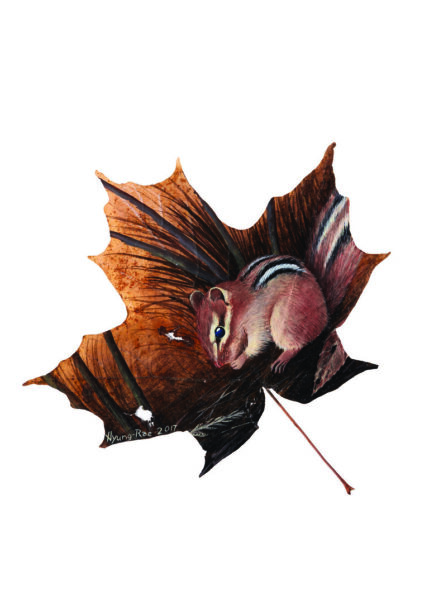
A leaf painting by Todd (Hyung-Rae) Tarselli animates such possibility. On a browned autumn leaf fallen from a maple tree, he has painted in realistic detail a chipmunk; microstrokes of brown, white, and red render the texture of fur along the animal’s body. The eye of its profiled face shines brightly. Behind the chipmunk, Tarselli has painted dark blades of grass and a harvest on which the animal nourishes itself—a scene from nature painted on a piece of nature created in a prison cell.
The life of the leaf as organic matter is part of the art, with holes on the surface from decomposing. Tarselli has spent years in solitary confinement, where he paints and draws scenes of nature. He also makes explicitly political art that condemns the prison industrial complex and embraces revolutionary and liberatory ideologies of previous social movements, knowledge of which he acquired through reading and learning from others held captive, as part of what Dylan Rodríguez calls “the radical prison praxis” of imprisoned intellectuals that continues to influence generations of people locked away. Tarselli’s work materializes the conditions out of which prison art emerges: penal space, penal matter, and penal time, concepts that I elaborate on in Chapter 1.
In brief, penal space is the architectural confinement and the sets of relations that imprisonment structures; penal matter is the limited access to material goods and objects for the production of culture in prison; and penal time is punishment measured as time in captivity or under state supervision, such as parole.
Art made in prisons is commonly described under the rubric of “outsider art” or “folk art,” meaning art made by artists who have no or little formal training or who create outside of established art institutions. Other studies have focused on art programs and workshops that are based on models of art therapy, which grow out of the disciplines of psychology, education, and criminology and which promote exploring creative outlets as forms of healing and rehabilitating people.
I do not employ the discourse of rehabilitative arts, although some of the artists and teachers I interviewed adhere to this framework. My main concern about a rehabilitative framework is that in its primary focus on changing the individual, it does not offer an analysis or critique of how the carceral state relies on producing criminal subjects and diminishing the life possibilities of entire populations.The framework of rehabilitative arts does not address the larger structural and political relationships that I attempt to map between art, aesthetics, and the carceral state.
Moreover, my engagement with art is through the lens of an abolitionist vision to end human caging and the conditions that produce prisons. So while I do not write about prison art as necessarily therapeutic or rehabilitative (as those concepts are used in penal and clinical settings), I do acknowledge and respect that many incarcerated artists use and understand art-making as part of their healing and coping inside prisons.
Art made in US prisons and detention centers (what some call “cellblock art” and others call “inmate art”) is so common that the Federal Bureau of Prisons has several pages of guidelines that regulate the making, distributing, and selling of art in carceral facilities. The guidelines give prison administrators wide authority over how each prison or jail handles art-making: “The Warden may restrict, for reasons of security and housekeeping, the size and quantity of all products made in the art and hobby craft program. Paintings mailed out of the institution must conform to both institution guidelines and postal regulations. If an inmate’s art work or hobbycraft is on public display, the Warden may restrict the content of the work in accordance with community standards of decency.”7U.S. Department of Justice, Federal Bureau of Prisons, Recreation Programs, Inmates, “Program Statement,” P5370.11, 6/25/2008, p. 12.
Under the warden’s discretion, the prison provides incarcerated people with the ability to mail art to friends or family (at the prisoner’s expense) and to give work to family members with approval during visits. In many institutions, incarcerated artists are also allowed to sell works under regulations by warden or staff that usually involve the prison taking a percentage of the sale. In the state of Ohio, for example, prisons take 20 percent of all art sales.
Art made by the imprisoned can be quite lucrative for some institutions, and art workshops and education can function as ways of managing people held captive so that they do not challenge prison authority. At Louisiana State Penitentiary, also known as Angola, prison art is widely sold at the biannual rodeo show, bringing insignificant profit to the institution and a percentage to incarcerated people who can use it toward commissary or can send it home to relatives.8Lucia Davis, “Inside the Angola Prison Hobbycraft Sale, Where Inmates Sell their Cre-ations,” Atlas Obscura, 14 January 2016, https://www.atlasobscura.com/articles/inside-the-angola-prison-hobbycraft-sale-where-inmates-can-sell-their-creations
In fact, most of these programs could not run without the permission of wardens and departments of correction who see the benefit of art-making to the operations of prisons. But in light of ways that prisons can instrumentalize prison art to maintain institutions, incarcerated artists and their nonincarcerated allies innovate and engage aesthetic practices that exceed and defy the strictures of prisons.
Moreover, prison art shifts how we think about art collections and art collectors. The primary collectors of art made in prison are other imprisoned people and their loved ones. Art proliferates in prisons, and substantial collections exist inside cells, storage units, and classrooms of carceral facilities.
Art proliferates in prisons, and substantial collections exist inside cells, storage units, and classrooms of carceral facilitiesPrison staff are also collectors of art made inside. Employees of prisons often commission incarcerated people to make art on their behalf and negotiate rates within the prison economy. These negotiations usually take place off record and between people occupying very different positions of power. “Commission” and “negotiation” are fraught terms to describe arrangements in which unfree artists are asked by people who hold enormous authority over their livelihood to make art in exchange for money, goods, or special treatment.
Most artists who described making work for prison staff discussed how they would barter with the staff for access to prohibited material or favors, including help getting clandestine art sent out of prison.
For incarcerated people, access to art-making and ownership of one’s art vary widely across prisons and detention centers. Some facilities have fully stocked art rooms and offer art classes in multiple genres. In others, incarcerated people create peer-run art groups where they share resources and teach each other techniques.
Artists often appropriate state material in the service of art, a practice that is a rule infraction and can result in work being confiscated and other forms of punishment. Their practices are highly surveilled, and art can be seized for many reasons. “Officers can confiscate pictures because of their subject matter. Nude pinups usually receive tacit approval so long as the art is enjoyed discreetly. It can be hung on cell walls in some prisons and not in others... If a painting can be interpreted as inciteful to riot, it will be confiscated. Images of violence against officers, gang symbols, racist insults, and offensive writing are forbidden,” writes Kornfeld. 9Kornfeld, Cellblock Visions, 12.
In places like the death row unit of Louisiana State Prison, condemned people are now legally prohibited from making art without the warden’s approval, after the art of one man on death row made it out and was sold online. A 2012 state law declares, “Any sketch, painting, drawing or other pictorial rendering produced in whole or in part by a capital offender, unless authorized by the warden of the institution,” is to be considered contraband, and creating it is a crime punishable by up to five years of imprisonment.10La. R.S. 14:402(D)(10); Cheryl Mercedes, “Website Obtains, Sells Convicted Killer’s Art,” WAFB, 30 January 2012, http://www.wafb.com/story/16635022 /convicted-baton-rouge-serial-killer-sells-artwork-from-prison Thanks to artist Deborah Luster and to Cormac Boyle of the Justice Center in Louisiana for bringing this law to my attention and sharing resources. The law was implemented as a measure to prevent people on death row from acquiring fame or financially profiting off their imprisonment.
The issue of ownership of and profiting from art made by the incarcerated turned into international news in 2017, when the Pentagon attempted to shut down Ode to the Sea: Art from Guantánamo Bay, an exhibit of art by current and former detainees at the military prison. The pieces were created in an official program in which detainees were provided access to art courses. The exhibit was widely praised, with reviews in the Paris Review, the New Yorker, the New York Times, and the Guardian.
One such painting, by Muhammad al Ansi, depicts the lifeless body of Alan Kurdi, the Syrian toddler who drowned in the Mediterranean Sea as his family sought refuge. Ansi based his painting on a widely circulated photograph of Kurdi’s dead body on a Turkish beach by Turkish photojournalist Nilüfer Demir.11Brandon Griggs, “Photographer Describes ‘Scream’ of Migrant Boy’s ‘Silent Body,’” CNN.com, 3 September 2015, https://www.cnn.com/2015/09/03/world/dead-migrant-boy-beach-photographer-nilufer-demir/index.html.
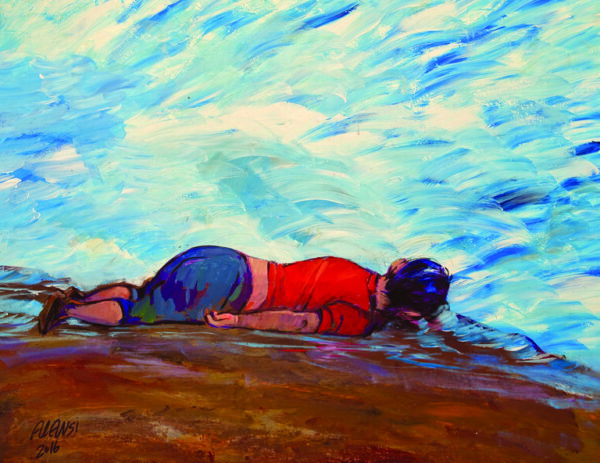
Though the Department of Defense had initially approved the art for the exhibition, stamping the backs of the works with “Approved by US Forces,” the US government subsequently appeared to have reservations about the works’ enthusiastic reception and the narrative of captivity emerging from news coverage.
It also objected to attempts at selling any of the works. As a result, the military has prohibited art from leaving the camp, meaning detainees can no longer give their works to their attorneys or family, which prior to the show had been common practice. The Pentagon released the following statement: “Items produced by detainees at Guantánamo Bay remain the property of the U.S. government.”12Carol Rosenberg, “After Years of Letting Captives Own Their Artwork, Pentagon Calls It U.S. Property. And May Burn It,” Miami Herald, 16 November 2017, http://www.miamiherald.com /news/nation-world/world/americas/guantanamo/article185088673.html According to this policy, detainees are no longer able to take their art with them if and when they are released. Instead, the military proposed incinerating art left behind.
As access to and ownership of prison art are contested, so too is the category itself. The term, as one art historian told me, leaves little to the imagination; it tells the audience what to expect before they even look. Similarly, a writer interested in the topic discouraged use of the term, warning that it suggested devalued Muhammad al Ansi, untitled (Alan Kurdi), 2016, and amateur forms of art-making. He was concerned that the term would diminish the aesthetic innovation of the art made inside prisons. Treacy Ziegler, an art instructor in prisons and curator of Without the Wall—an art exhibit of works by anonymous artists, half of whom were incarcerated — offers a similar critique of the category.
In curating the show, Ziegler queried, “Can we experience art without the story of the artist?” 13Rachel Heidenry, “ ‘Without the Wall’ Explores Identity and Incarceration at Philadelphia’s City Hall,” Artblog, 9 July 2014, http://www.theartblog.org/2014 /07/without-the-wall-explores-identity-and-incarceration-atphiladelphias-city-hall/. Without the Wall attempted to challenge the public’s conception of prison art by asking audiences to consider their investments in interpreting such work through stereotyped ideas about the themes, genres, and media used by incarcerated artists. But a journalist reporting on the exhibition also noted the contradiction in this curatorial exercise, arguing that much of the draw of the show for audiences was that some of the art came from prison.
How does art made in captivity challenge familiar assumptions about what it means to be imprisoned while still revealing the institutional constraints out of which it emerges? Questions about the terminology we use for prison art and the conditions in which it gets produced have become even more timely as art by incarcerated people circulates more widely in the public sphere. During an artist talk that I moderated with a formerly incarcerated artist, a man in the audience commented on how rarely we discuss the significance of the setting in which works are made when looking at art by nonincarcerated people.
The formerly incarcerated artist agreed, but also made clear that when a piece of art is made in prison, it is impossible not to acknowledge the significance of the institutional context. He noted that his artwork changed significantly when he went to prison because of the setting, the regulation of time, the constant presence of correction officers, and the limited access to materials—all of which altered his aesthetic horizon. For him, penal time, penal matter, and penal space led to a more deliberate, repetitive, and sometimes even mechanical process—one that produced labor-intensive, time-laden works that he would not have made outside punitive captivity.
I use the term “prison art” instead of “prisoner art” because I think the former is more capacious and expansive and also includes art made in collaboration with nonincarcerated artists. It is a term that attempts to destigmatize incarcerated artists while gesturing at the ways that incarceration reaches far beyond prison walls and the ways that mass imprisonment impacts aesthetics and culture more broadly. These creative practices become more urgent and grow in scale and number as survival strategies in the wake of mass incarceration. With the growth of prisons over the past few decades, the modes of resistance and forms of culture made by imprisoned people have expanded.
Copyright © 2020 by the President and Fellows of Harvard College. All rights reserved.

Nicole Fleetwood | USA |
Holds a BPhil (1994) from Miami University and an MA (1998) and PhD (2001) from Stanford University. From 2005 to 2021, she was affiliated with Rutgers University at New Brunswick, with appointments in the Departments of American Studies and Art History. Fleetwood is currently the James Weldon Johnson Professor in the Department of Media, Culture, and Communication at New York University. Her additional publications include the books Troubling Vision: Performance, Visuality and Blackness (2011) and On Racial Icons (2015) and articles in Artforum, African American Review, Aperture, Callaloo, and LitHub. Fleetwood’s co-curated exhibitions have appeared at the Andrew Freedman Home, Aperture Foundation Galleries, and Zimmerli Museum of Art, among other venues.
